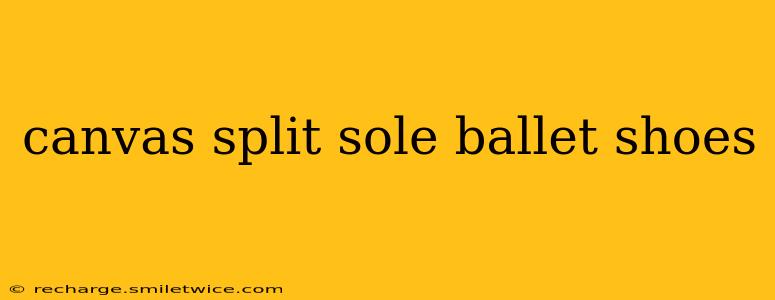Canvas split sole ballet shoes are a staple for dancers of all levels, offering a unique blend of comfort, flexibility, and support. Unlike full-sole shoes, the split sole design allows for greater articulation of the foot, making them ideal for developing pointe work, strengthening arches, and improving overall technique. This comprehensive guide explores everything you need to know about canvas split sole ballet shoes, helping you choose the perfect pair and optimize their use.
What are the Benefits of Canvas Split Sole Ballet Shoes?
Canvas split sole ballet shoes offer several key advantages over full-sole options:
- Increased Foot Flexibility and Articulation: The split sole allows for a greater range of motion in the foot, crucial for developing proper technique, especially in pointe work. This allows for a more natural feeling connection to the floor.
- Enhanced Foot Strength: Because the sole is split, the intrinsic muscles of the foot work harder to maintain stability and balance. This contributes to stronger arches and improved foot health.
- Improved Proprioception: The increased awareness of foot placement and movement helps dancers develop better body awareness and balance.
- Lightweight and Breathable: Canvas is a lightweight and breathable material, keeping your feet cool and comfortable during long rehearsals or performances.
- Affordable Option: Compared to leather split-sole shoes, canvas versions offer a more budget-friendly choice, making them ideal for beginners or those who frequently need replacements.
How Do Canvas Split Sole Ballet Shoes Differ from Leather Split Sole Shoes?
While both canvas and leather split sole ballet shoes share the same basic design, key differences exist:
- Durability: Leather is significantly more durable and long-lasting than canvas. Canvas shoes wear out more quickly, especially with frequent use.
- Support: Leather generally provides more support and structure to the foot, particularly for dancers with low arches.
- Breathability: Canvas offers superior breathability, while leather can be less breathable, especially in warmer climates.
- Cost: Leather shoes are typically more expensive than canvas options.
- Break-in Period: Leather shoes require a break-in period to soften and mold to the shape of the foot, whereas canvas shoes are typically more immediately comfortable.
What Size Canvas Split Sole Ballet Shoes Should I Buy?
Choosing the right size is crucial for comfort and proper technique. Generally, canvas split sole ballet shoes should fit snugly but not too tightly. Your toes should be able to wiggle slightly, and there shouldn't be any excess space in the heel. Many dancers find it helpful to go up half a size from their street shoe size. Consult with a dancewear professional for personalized sizing advice.
How to Care for Your Canvas Split Sole Ballet Shoes?
Proper care extends the lifespan of your canvas split sole ballet shoes:
- Air them out: After each use, allow your shoes to air out completely to prevent the buildup of moisture and odor.
- Spot clean: Clean any dirt or grime with a damp cloth and mild soap. Avoid submerging the shoes in water.
- Stuff them with paper: When not in use, stuff your shoes with acid-free tissue paper to maintain their shape.
- Rotate your shoes: Having multiple pairs allows for proper airing and reduces wear and tear on a single pair.
Are Canvas Split Sole Ballet Shoes Suitable for Beginners?
Yes, canvas split sole ballet shoes are an excellent choice for beginners. Their affordability and comfort make them ideal for developing basic technique and building strength.
Where Can I Buy Canvas Split Sole Ballet Shoes?
Canvas split sole ballet shoes are widely available from dancewear stores both online and in person. Many major dance retailers carry a wide selection of sizes and styles.
This guide offers a comprehensive overview of canvas split sole ballet shoes. Remember that the best type of shoe depends on individual needs and preferences. Consulting with experienced dance instructors or professionals can provide further guidance on choosing the appropriate footwear to support your dancing journey.
